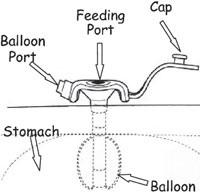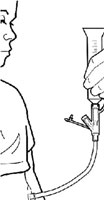Your child’s PEG tube has been replaced with a low-profile gastrostomy-button (or G-button). Like a PEG-tube, you can feed your child or give medicine through a G-button.
The button has a water-filled balloon on the inside that holds it in place.
G-buttons need to be replaced for different reasons (balloon leaks, your child grows, etc.). We recommend changing them every four months and will show you how to do this.

You should always have a replacement button at home. If you don’t, call your home health supplier. It is often good to carry a plastic bag with an extra G-Button, syringes, and lubrication in your purse or diaper bag.
Things to do at least once a day
- Check the G-button and stoma (hole), especially before and after feeding.
- Use a cotton swab or soft cloth to clean the skin around the button with mild soap and warm water.
- Check for leaking, redness, pus, or bleeding around the tube.
- Check that you can see a little of the tube and that it is not too tight or too loose against the skin.
Introduction to tube feedings

Just like the PEG tube, you may use the button for either bolus or continuous feeds.
Bolus feedings (formula given over 10 – 20 minutes) and medications are given with a bolus connecter and a small slip-tip syringe.
Continuous feedings (formula given over 8 – 24 hours) are given with a continuous feeding connector, a special pump and feeding bags.
Frequent issues
Tissue around button is pink-red and moist:
This is granulation tissue and is common. Call your health care provider if the tissue bleeds, grows in size, or if fluid or pus leaks.
Fluid leaks around the button:
Leaks don’t usually cause problems except minor irritation. The button should be resting lightly against the skin. If it is loose, check the balloon since it loses water slowly over time.
To check the balloon:
- Insert a 5 to 10cc syringe into the balloon port (see picture on other side).
- Remove the water. The amount that should be in the balloon is on the top of the button or in the instruction book.
- Add water if necessary. If the balloon leaks, the button needs to be replaced. (See the “Use and Care of a G-Button” brochure).
The button is clogged:
Never force fluid through the button. If appropriate for your child’s diet, try a half ounce of cola through the button. Remember to flush with lukewarm water before and after feedings or medications to help prevent clogs.
The button came out:
Buttons come out if the balloon lost water or if it is pulled by accident. Find the “Use and Care of a G-Button” brochure on how to put tubes or buttons in the stoma and follow the steps below:
- Check the balloon. If water doesn’t leak, put it back in.
- If the balloon doesn’t work, use your replacement button. Call your home health company as soon as possible to get another button for the future.
- If you have nothing to put in the stoma, replace the old button and tape it down. This will keep the stoma open until you can seek medical attention.
- If you can’t get anything back into the stoma, call us or go to the ER. The sooner you get there, the more likely we will be able to replace a button or tube before the stoma closes.
Call your health care provider if:
- The stoma (hole) is red and/or sore
- The stoma is swollen and/or bleeding
- Pus leaks from the stoma
- Fevers without a cause (like a cold)
- Pain with feedings or moving the tube
- Vomiting
- Any time you have questions or concerns